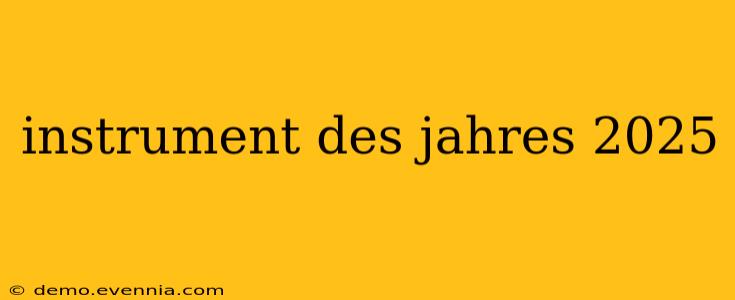Predicting the "Instrument of the Year" is a tricky business. Musical trends are fickle, and what's hot one year can be passé the next. However, by analyzing current trends in music technology and the evolving needs of musicians, we can make some informed speculations about potential contenders for the title of "Instrument des Jahres 2025." While a definitive winner is impossible to name this far out, we can explore some strong candidates and the factors that might propel them to the forefront.
The Rise of AI-Enhanced Instruments
Artificial intelligence is rapidly transforming the music landscape. We're likely to see more sophisticated AI-powered instruments in 2025, instruments that go beyond simple sound generation. Imagine instruments that:
- Learn your playing style: Adaptive algorithms analyze your playing and adjust parameters to optimize your performance, offering personalized feedback and suggestions.
- Compose in real-time: AI could assist in improvisation and composition by suggesting melodic or harmonic ideas based on your input.
- Generate unique soundscapes: These instruments could blend various traditional and electronic sounds, creating entirely new sonic palettes.
Modular Synthesis Takes Center Stage
Modular synthesis, once the domain of niche electronic music producers, is experiencing a surge in popularity. Its flexibility and potential for creating unique sounds make it a strong contender for future acclaim. Expect to see:
- More accessible modular systems: Smaller, more affordable systems will lower the barrier to entry, encouraging broader experimentation.
- Improved software integration: Seamless integration with DAWs (Digital Audio Workstations) will make modular synthesis more user-friendly for a wider range of musicians.
- Innovative modules: Expect new modules that push the boundaries of sound design, incorporating AI, generative algorithms, and advanced effects processing.
The Evolution of Hybrid Instruments
The line between acoustic and electronic instruments is increasingly blurred. Hybrid instruments, blending the organic feel of acoustic instruments with the flexibility of electronic components, will likely continue their rise:
- Smart guitars and basses: Expect guitars with built-in effects processors, MIDI capabilities, and advanced modeling software, allowing for unparalleled customization and sound manipulation.
- Augmented pianos and keyboards: Digital pianos will incorporate increasingly sophisticated sound engines and advanced features like responsive key actions and intelligent voicing.
- Enhanced orchestral instruments: Expect developments in digital orchestral instruments, capable of simulating the nuances of acoustic instruments with unprecedented accuracy.
Sustainable and Accessible Instruments
Environmental awareness and inclusivity are shaping the future of musical instrument design. Expect to see:
- Instruments made from sustainable materials: Manufacturers will increasingly prioritize eco-friendly materials and manufacturing processes.
- Affordable and adaptable designs: Instruments designed for diverse body types and skill levels will promote broader participation in music making.
- Open-source hardware and software: This will encourage collaboration, customization, and accessibility for musicians worldwide.
Beyond the Instrument: The Importance of Software and Interfaces
The "Instrument des Jahres 2025" might not be a single device, but rather a holistic ecosystem of software and hardware. Intuitive interfaces, powerful software, and seamless integration between different devices will be crucial factors determining the success of future musical instruments.
Conclusion:
Predicting the future is inherently uncertain, but by examining current trends, we can anticipate the likely direction of music technology. The "Instrument des Jahres 2025" will likely be a product of innovation across multiple areas: AI integration, modular synthesis, hybrid designs, and a commitment to sustainability and inclusivity. It will be an instrument that empowers musicians with greater creativity, flexibility, and accessibility than ever before. The journey towards that future is exciting to witness.

